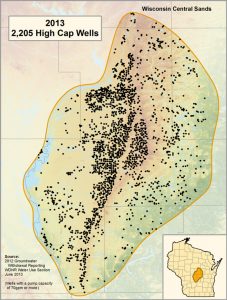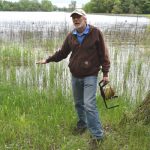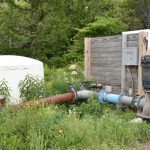State loosens high capacity well restrictions
By Ben Rodgers
A bill recently signed into law by the governor on June 1 will impact waters in central Wisconsin.
On the surface, Senate Bill 76 allows businesses and farmers the ability to sell, repair or replace high capacity wells.
But just below the surface is where opponents of this bill find problems.
These wells can withdraw as much as 100,000 gallons of groundwater per day, according to the Wisconsin Department of Natural Resources.
There are roughly 2,200 high capacity wells in the region.
The region is home to the Central Wisconsin Sands and Gravel Aquifer, which supplies the groundwater that feeds many lakes and streams in the area.
The Central Sands Region includes parts of Waupaca, Shawano, Marathon, Portage, Adams, Wood, Waushara and Marquette counties.
When irrigation for crops was just starting the in 1960s the region was home to 97 wells.
“When we pump groundwater we are always lowering water levels in the aquifer and were depriving the streams from some water as well,” said George Kraft, director of the Center for Watershed Science and Education at the University of Wisconsin-Stevens Point and the University of Wisconsin Extension Service.
The end result is some lakes and streams near high capacity wells are faced with historically low levels.
Long Lake in Waushara County is the most prominent example, but numerous other lakes here are faced with low levels. Closer affected lakes include Wolf Lake and Pickerel Lake in Portage County.
Research indicates these decreased water levels are directly tied to the increase in pumping.
“Within any kind of scientific certainty, yes we can say that,” Kraft said.
For example, Kraft said to imagine an aquifer that is 100 feet thick and feeds into a lake. If pumping decreases the top 5 feet of that aquifer, that would have an impact on the water level in that lake.
However, other lakes in the region further away from a concentration of high capacity wells have seen high water levels due to recent weather trends.
Lake Emily in Portage County is one those lakes currently with near historic highs.
“In the last few years, we are at near historic amounts of precipitation, so that masked the pumping issue,” Kraft said. “But once we go back to normal again, it will become quite apparent.”
 Kraft has maps that show the number of wells and the water levels of the lakes and streams close to them.
Kraft has maps that show the number of wells and the water levels of the lakes and streams close to them.
The data shows bodies of water tend to have lower water levels when they are closer to more high capacity wells.
“We have some solid things that we can hang our hat on with the pumping effects,” he said.
The Wisconsin Potato and Vegetable Growers Association, based in Antigo, has come out in support of SB 76, which decreases high capacity well regulation.
“It address the DNR’s authority related to existing high capacity wells,” said Tamas Houlihan, WPVGA executive director. “The wells affected by this legislation have already been DNR approved but are in need of repair or replacement, and so new DNR approval of these existing and previously approved wells would be redundant.”
Houlihan also said time is of the essence when it comes to the protection of crops in Wisconsin. Wells in need of repair could have significant financial impacts.
“In some cases, the wells have reached a point of disrepair where they must be redrilled and that would be a replacement well, and it’s important to note a grower can lose a crop within 24 hours if a well fails and can’t be quickly repaired or replaced,” he said.
He also stressed the bill includes a required hydrological DNR study of four identified areas in central Wisconsin. The studies will evaluate whether groundwater withdrawals are impacting lakes and streams. The studies will be presented for public comment before they come before the legislature.
“We believe these studies are critical to understanding the interaction between groundwater and surface water,” Houlihan said. “We support the scientific work that will generate reliable data upon which any necessary future regulations can be developed.”
Plus repaired and replaced wells will be required to have a meter that reports water usage to the DNR.
He said current irrigation techniques are critical to Wisconsin and the world when it comes to agriculture production.
“We are a huge factor in the nation’s and really the world’s supply,” Houlihan said. “The Central Sands growing region is critically important to the entire United States in terms of food production.”
The Wisconsin Farm Bureau did not return a call for comment on this story, but released a statement following the signing of SB 76 into law.
“It is important for farmers with high capacity wells to have financial and regulatory certainty,” said Jim Holte, Wisconsin Farm Bureau president, in the press release.
While it’s no secret that agriculture is king in Wisconsin, the argument made by conservationists is Wisconsin’s water belongs to everyone.
“It’s OK to have some certainty for a farmer. That’s not a problem. Everyone appreciates the need of water for farmers,” said Bob Clarke, president of Friends of Central Sands, a nonprofit advocacy group. “But there also needs to be some certainty for landowners and the environment.”
Clarke likens the scenario to a drinking glass with one straw in it. Now imagine the same glass with 20 straws and how much faster it will empty.
“Unfortunately, if you drive through Wisconsin you see the pretty fields, you see the agriculture, you see the sprinklers going on, you truly do not think about this,” he said. “Unless you see one of these lakes and the damage being done and the damage that has been done, you never know.”
This issue gained momentum in 2004 when a bipartisan groundwater protection act was passed.
“It was done with the goal of adding protections for groundwater, it was done with the support of agriculture community, it was widely recognized as the first step with many steps to come to get to sustainable protection. Unfortunately, the 2004 law is as far as anything got,” said Amber Meyer Smith, director of programs and government relations for Clean Wisconsin, an environmental advocacy group.
In 2008, a lake association took the DNR to court because it felt the agency wasn’t doing its job of monitoring the lake levels.
In 2011, the Wisconsin Supreme Court established, as a result of the 2008 lawsuit, that the DNR should be looking at surface water impacts on lakes. It was established in 2014 by a administrative law judge that the DNR should be looking at the cumulative impact of high capacity well approval, together with all the other watershed withdrawals happening in the area.
“Then because court cases were establishing protection, I think that made some of the (high capacity well) permit holders uncomfortable and they took their case to the AG (attorney general) and the AG issues an opinion that we very strongly disagree with that says the DNR doesn’t have the authority to do any of that reviewing,” Meyer Smith said.
Last year, an opinion from Attorney General Brad Schimel stated the DNR does not have the responsibility to do any reviewing on water levels except in a few very narrow situations.
This leaves the agency with “natural resources” in its name without the ability to monitor one of Wisconsin’s natural resources, she said.
SB 76 strips the DNR of another level of review it has been doing, to monitor the repair, replacement and transfer of these wells, Meyer Smith said.
“Where that leaves us is with very, very minimal protection for groundwater at this time, and it leaves the DNR acting pretty much as a rubber stamp even when they know there are natural resource impacts,” she said.
Both representatives from this area, Sen. Luther Olsen and Rep. Kevin Petersen voted in favor of the bill.
As of June 5, Olsen has not returned multiple phone calls for this story.
Petersen declined to comment, instead referring the Waupaca County Post to his latest newsletter for his stance on the issue. The newsletter has not yet been distributed as of June 8.
Meyer Smith and Clean Wisconsin are based in Madison. The organization spends time and resources lobbying for issues to protect the environment.
She said this issue is vexing because the majority of Wisconsin lawmakers have sided with agriculture.
“This is a giant issue and the unwillingness of some legislators to put in sustainable protections, to try and find a balance between protecting natural resources and protecting agricultural interests, is really disappointing,” Meyer Smith said. “To tell people who live along a lake that their property rights don’t matter and the only solution they have is to go to court to protect their property I think is extremely disappointing.”
While the Central Sands region is where the spotlight is currently when it comes to high capacity wells, Meyer Smith said the problem is becoming more evident elsewhere in Wisconsin.
“The Central Sands is certainly where this is best known because of the huge, exponential growth of high capacity wells in the area and the cumulative impact they’re all having on the ground water,” she said. “However, problems are starting to spring up in the northwestern corner of Wisconsin, and I know scientists are becoming increasingly concerned with the amount of water withdrawals there. Frac sand mining and growth of those operations might mean the future for sustainability for those aquifers.”


